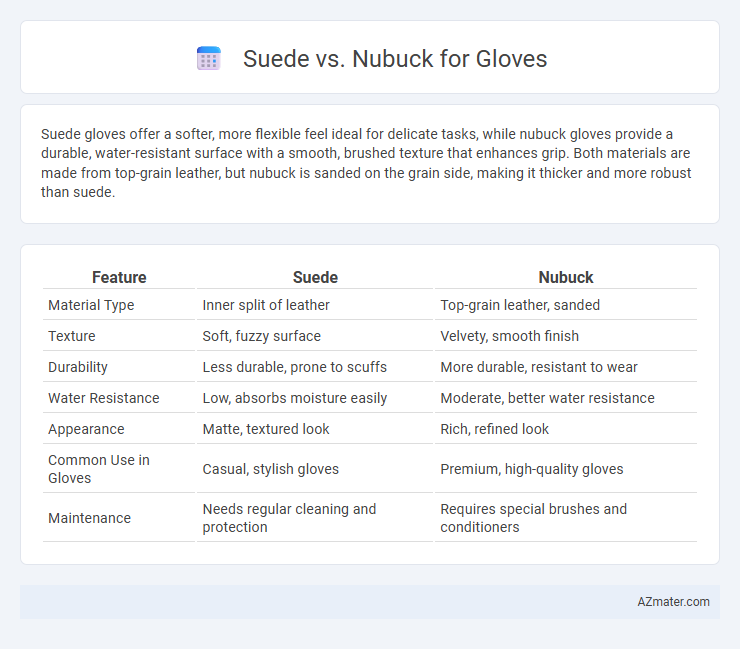Suede gloves offer a softer, more flexible feel ideal for delicate tasks, while nubuck gloves provide a durable, water-resistant surface with a smooth, brushed texture that enhances grip. Both materials are made from top-grain leather, but nubuck is sanded on the grain side, making it thicker and more robust than suede.
Table of Comparison
| Feature | Suede | Nubuck |
|---|---|---|
| Material Type | Inner split of leather | Top-grain leather, sanded |
| Texture | Soft, fuzzy surface | Velvety, smooth finish |
| Durability | Less durable, prone to scuffs | More durable, resistant to wear |
| Water Resistance | Low, absorbs moisture easily | Moderate, better water resistance |
| Appearance | Matte, textured look | Rich, refined look |
| Common Use in Gloves | Casual, stylish gloves | Premium, high-quality gloves |
| Maintenance | Needs regular cleaning and protection | Requires special brushes and conditioners |
Understanding Suede and Nubuck: Key Differences
Suede gloves feature a soft, napped finish created from the underside of animal hides, offering a delicate texture ideal for lightweight and breathable wear. Nubuck gloves are crafted from the outer grain of the hide, sanded to create a fine, velvety surface that provides enhanced durability and resistance to wear. The primary difference lies in the texture and strength: suede is softer and more flexible, while nubuck delivers a sturdier, more resilient glove suited for heavy-duty use.
Origins and Materials Used in Suede and Nubuck Gloves
Suede gloves are crafted from the underside of animal hides, typically from lamb, goat, or calf, resulting in a soft, napped finish with a supple texture ideal for dexterity and comfort. Nubuck gloves originate from the outer grain of the hide, often from cowhide, which is sanded or buffed to create a velvety surface that is more durable and resistant to wear than suede. Both materials offer a distinct tactile experience, with suede providing a finer, more pliable feel while nubuck combines strength with a luxurious, smooth appearance.
Texture and Appearance Comparison
Suede gloves feature a soft, napped texture with a velvety finish that provides a smooth, matte appearance ideal for a refined and cozy look. Nubuck gloves, made from top-grain leather sanded on the outer side, offer a slightly coarser texture with a subtle sheen that enhances durability and a more polished, luxurious aesthetic. Both materials provide excellent grip and comfort, but nubuck's tougher surface makes it more resistant to wear while suede offers superior softness and flexibility.
Durability: Which Material Lasts Longer?
Nubuck gloves offer superior durability compared to suede due to their denser grain structure, making them more resistant to wear and tear. Suede, while softer and more flexible, tends to show signs of abrasion and damage faster under heavy use. For long-lasting gloves, nubuck's tougher surface makes it the preferred material, especially in high-contact environments.
Comfort and Feel: Suede vs Nubuck Gloves
Nubuck gloves offer a velvety, smooth texture due to their fine sanding, resulting in exceptional softness and a supple feel that enhances comfort during extended wear. Suede gloves, made from the underside of the hide, provide a slightly rougher yet pliable touch, balancing breathability with a cozy fit. Both materials allow good flexibility, but nubuck's denser grain often delivers a more luxurious, cushioned sensation on the hands.
Breathability and Warmth Properties
Suede gloves offer moderate breathability due to their porous leather surface, making them suitable for cool weather conditions while maintaining flexibility. Nubuck gloves feature a finer, brushed grain with slightly tighter fibers, providing enhanced warmth and better insulation against cold temperatures compared to suede. Both materials balance comfort and protection, but nubuck excels in retaining heat, whereas suede allows for greater air circulation.
Maintenance and Cleaning Tips for Each Material
Suede gloves require gentle cleaning with a soft brush or specialized suede cleaner to maintain their texture and avoid water spots, while Nubuck gloves benefit from regular brushing with a nubuck cloth to remove dirt and restore their nap without soaking. Avoid using water directly on both materials; instead, apply suede or nubuck conditioners to keep the leather supple and prevent cracking. Store gloves in a cool, dry place away from direct sunlight to preserve color and shape for longer-lasting wear.
Price and Value: Cost Comparison
Suede gloves typically cost less than nubuck gloves due to the simpler production process and lower material grade, making them a budget-friendly option for everyday use. Nubuck gloves demand a higher price because of their premium, sanded leather finish, which offers enhanced durability and a luxurious feel. The value of nubuck lies in its longevity and refined appearance, justifying the upfront cost for those seeking a blend of style and resilience in gloves.
Style and Popular Uses in Glove Design
Suede gloves offer a soft, velvety texture that enhances elegance and are often favored in fashion-forward designs and formal occasions. Nubuck gloves, with their fine, brushed surface, provide a slightly more rugged yet refined look, making them popular for casual wear and outdoor activities. Both materials deliver excellent grip and comfort, with suede emphasizing sleek style and nubuck prioritizing durability and versatility.
Choosing the Best Material for Your Needs
Suede gloves offer a soft, flexible texture ideal for light to moderate use, while nubuck gloves provide enhanced durability and water resistance due to their buffed outer surface. For tasks requiring both protection and breathability, nubuck is preferable, especially in outdoor or heavy-duty environments. Suede remains a favored choice for comfort and style in less demanding situations, making the decision reliant on balancing durability with tactile softness.

Infographic: Suede vs Nubuck for Glove
 azmater.com
azmater.com